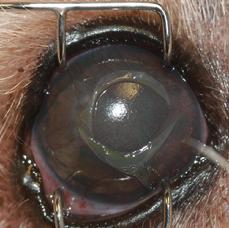Burr Keratotomy
Burr Keratotomy
It is not uncommon to for a pet to end up with damaged corneal tissue, so if you notice there is something wrong with your pet’s eyes, make sure you give us a call and schedule an appointment. Do not take any chances here, because these issues can cause permanent harm to the animal’s vision if left untreated. Corneal ulcers that have been treated aggressively with no resolution may in fact be an Indolent Ulcer.
An indolent ulcer is a superficial ulcer which is resulting from the failure of epithelial adhesion to the corneal basement membrane and stroma. Typically this is an age related ulceration which commonly affects boxers but any breed can be affected.
Indolent Ulcer’s can cause a variety of clinical signs: squinting, enlarged vessels, third eyelid elevation, ocular discharge, corneal edema and small pupils. Usually the initial diagnostic tests to have performed include; Schirmer Tear Test, Fluorescein Dye and Intraocular Pressures. The procedure itself is not that complicated, and our experienced team is capable of providing experienced veterinary care at a low cost.
Burr Keratotomy is a procedure which removes the outer layers of the affected corneal tissue.It is most commonly performed while a pet is under the influence of sedation or in some cases a general anaesthesia. Once the procedure is over, the patient is sent home with an e-collar and the prescribed medication. Do not be alarmed – this is a safe low cost procedure. Our main priority is the wellbeing of your pet. Burr Keratotomy is our preferred treatment in dealing with indolent ulcers and also holds a higher success rate.
Grid Keratotomy
Another procedure known as grid keratotomy is often performed on slow healing corneal ulcers (Indolent Ulcers to be exact). After applying a topical anaesthetic, the eye of the patient will be cleansed with a dilute surgical scrub. This way the abnormal epithelium is efficiently eliminated. An e-collar is used to ensure that the animal does not cause any additional trauma and hinder the healing process. Once the procedure is finished, it takes between 7-10 days for the affected area to fully heal. During that time you will have to administer the prescribed medication approximately four times a day. These are usually topical antibiotics, and they are applied directly on the eye.







